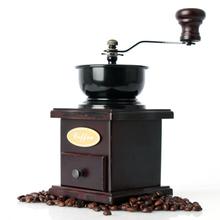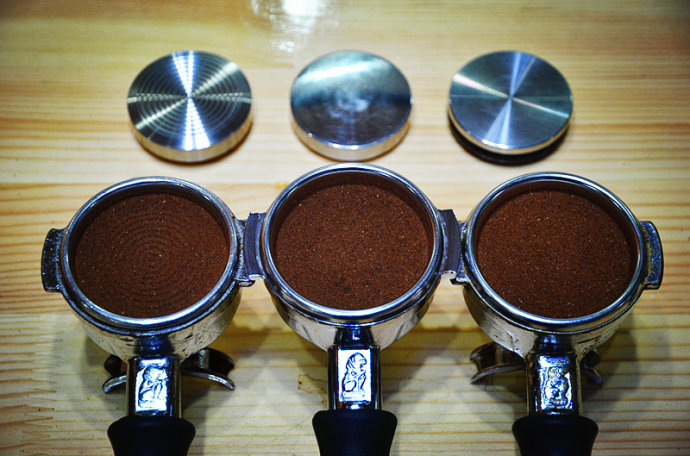Debugging and selection of Italian coffee grinder the difference between electric hand-operated household bean grinder

(Ⅳ)
Chapter 4 Espresso Grinder
When Espresso doesn't cook right, it's often hard to pinpoint the exact cause. That's because there are so many variables that make good coffee, and they're all interconnected, that just the slightest mistake (like stale beans, the wrong temperature of hot water) can ruin an espresso! The quality of the bean grinder was the most important factor.
Why is the bean grinder so important?
The reason is based on the way espresso works:
The water pressure is high and the brewing time is short.
brewing time
The so-called "brewing time" refers to the time it takes hot water to penetrate the coffee powder. Ideally, hot water under high pressure contacts coffee powder for about 25 to 28 seconds. Such a short time does not allow water-soluble aromatic substances to slowly dissolve out. (Using a drip filter or French press takes longer, 3 to 5 minutes.)
With a longer brewing time method, a cheap propeller grinder is enough. The espresso cooking method is fast and fierce, and there is no margin for error. It requires more precise grinding. The grinder plays an important role. After the beans are torn into powder, the tangled surface of these particles greatly increases the overall surface area. Hot water can easily extract the maximum concentration of delicious coffee fat evenly.
high pressure water
Modern espresso machines, which use rotary pumps, can produce 125 pounds of water pressure (equivalent to 9 atmospheres). The compacted coffee cake is less than half an inch thick, but it has to withstand such a large pressure, and the first job of the grinder is to make the ground coffee powder have a balanced resistance.
As I mentioned earlier, water will always "run" the way of least resistance, regardless of your dreams of making the perfect coffee. But when the beans are properly ground, the water will behave obediently.
To understand the complexity of this, it is best to look at microscopic photographs of coffee powder. (Thanks to Dan Hallett at Seattle Swedish Hospital for his help.)
The sharp-edged blades of commercial grinders tear the beans evenly into irregular polygonal spaces, providing maximum contact surface area where hot water and aromatic oils meet, thus maximizing the amount of delicious substances extracted in 25 seconds. And bad substances and caffeine, but there is no chance of a large outflow, espresso is good or bad difference here.
When the blade is blunt, the grinding particles turn into irregularly sized piles of powder. Such a short brewing time, hot water can not fully penetrate the large powder, resulting in insufficient extraction. Too small a dough can be over-extracted, dissolving bitter and slightly alkaline substances (a problem with propeller grinders), which makes it impossible to cook perfect espresso.
Bean grinder blade
What kind of grinder can make even grinding? The conditions are as follows:
1. Blade speed should be low, you can adjust the thickness.
2. Within the practical adjustment range of the bean grinder, the grinding teeth should be absolutely parallel.
3. The thickness adjustment mechanism must be capable of almost endless fine adjustments.
4. The drive motor must be bold enough not to overheat.
5. The manufacturer must provide spare grinding plates and replace them easily.
6. The heat generated inside the bean grinder should be exhausted by forced ventilation.
7. Do not use the grinder directly driven by the motor shaft, use the belt indirect drive mode, can avoid the heat conduction of the motor to the blade.
Many bean grinders adjust the thickness of the beans one by one, with a pointer or indicator on the dial. When the blade wear, blade gap will become larger, the original set thickness is not accurate. These machines can be adjusted just a little bit and the extraction time can vary from five to ten seconds. A skilled bar can be fine-tuned (see Chapter 16: Adjusting the Grind).
There are two types of bean-grinding knives:
1. planographic blade
2. conical blade
It is generally believed that tapered blade is better, because its cutting edge is longer, the speed can be reduced, and the damage of grinding heat to beans can be reduced. Whatever the difference is, in my experience tapered blades are better (we think parallel/tapered blades are best) because the espresso is thicker and sweeter and bigger. There's no "machine smell" in the coffee.
Commercial grinder powerful, low speed, precision structure, blade parallelism, will not make coffee heat, thickness can be precisely adjusted, so the price is high.
Blade leaves must be sharp
Everyone knows I've been nagging, saying "blade blunt" over and over again. Actually, my nagging is reasonable, because the blade has a fixed service life. Usually parallel blades can grind to 600 pounds of beans, conical blades can grind to 2000 pounds without problem.
600 beans per grind for a parallel blade, of course, very damaging. But then the beans will love you and the customers will love you.
After the blade is blunt, the texture of espresso will become thinner and the cooked one will become a small cup. But don't forget that to figure out what's really causing espresso to deteriorate, you have to control other variables first. For example, whether the beans are stale or the blade is blunt, the espresso cooked is exactly the same!
Clean the tool holder before replacing the blade. Lock the screw action to apply force evenly, slowly lock. Screw teeth attached to the powder particles with a blade or sharp awl clean, do not oil, small steel brush is also very good to use.
The method in my shop is still not ideal
Espresso special grinder dose dispenser inside, can hold up to 200 grams of coffee powder, through the ratchet drive group to drive the rotating fin, send out the appropriate dose of coffee powder. "Answer! "One click for a single dose. "Answer! Answer! "Two sounds, double dose.
There was a problem with this design: the dispenser had to be at least half full to deliver the right amount of coffee powder. But with all the coffee powder in it, the freshness is ruined. Don't forget that freshly ground powder oxidizes as soon as it comes into contact with air. A little longer, and the fragrance will disappear.
The way in our shop is: "grind one cup at a time." When pouring out the coffee powder, knock the machine five or six times to make the powder fall off. But the dispenser broke down quickly, and the rotating fins stirred the air and coffee powder together again. It is desirable to have an airtight exit ramp.
Our method also has problems. We only grind one cup at a time. We keep turning it on and off. It hurts the motor and generates more heat. We use a non-commercial bean grinder (itself is not used for a large number of grinding), each time the motor starts, the capacitor discharge circuit will heat up, the switch and distributor moving parts wear quite heavy, often have to replace, quite troublesome. You have to have your own inventory of related parts.
The heat from grinding the beans builds up, and at about 10 a.m., after grinding 15 pounds of beans, the powder feels warm. The two ounces of thick, delicious espresso that was brewed early in the morning became thinner, less flavorful, and smaller as the coffee powder was heated and the fat was severely damaged.
I am pleased to announce that the problem of "heat" has been solved! We installed a silent cooling fan for computers on the back of the bean-grinding machine. As long as the bean-grinding machine was plugged in, the fan would start. No matter how much you grind, the grinder doesn't get hot. (Note: The fan sucks in fine powder, so vacuum once a week.)
If you're planning on using my forced ventilation method to dissipate heat, remember to ask a professional mechanic to help you with the vents. Install fan, wiring to find professional electrician. Espresso bar is a very professional place of business, like DIY guy to restrain some, do not mess around.
Espresso Coffee: Professional Techniques 1996 Edition
Source: Bolan Coffee College
Important Notice :
前街咖啡 FrontStreet Coffee has moved to new addredd:
FrontStreet Coffee Address: 315,Donghua East Road,GuangZhou
Tel:020 38364473
- Prev

The strength and skill of pressing coffee powder has a great influence on the quality of coffee.
(Ⅵ) the most mysterious thing about pump pressure brewing coffee is that roasted beans not only contain fragrant flavor, but also contain other substances that taste bad. At the beginning of this century, the Italians found the correct conclusion: pressurizing water can separate these two kinds of substances more effectively. The oil is emulsified and extracted under pressure to form a reddish-brown foam-like crema.
- Next

The basic concept of Coffee the basic principles of espresso Espresso factors affecting coffee
The establishment of a knowledge structure based on Espresso principles is just a bunch of facts, just a bunch of facts. Theory is the skeleton of fact. The experience of teaching others to cook espresso taught me one thing: if I told newcomers about the basic theory of espresso at the beginning, after the course was over, it would be easier for them to cook well on their own.
Related
- Beginners will see the "Coffee pull flower" guide!
- What is the difference between ice blog purified milk and ordinary milk coffee?
- Why is the Philippines the largest producer of crops in Liberia?
- For coffee extraction, should the fine powder be retained?
- How does extracted espresso fill pressed powder? How much strength does it take to press the powder?
- How to make jasmine cold extract coffee? Is the jasmine + latte good?
- Will this little toy really make the coffee taste better? How does Lily Drip affect coffee extraction?
- Will the action of slapping the filter cup also affect coffee extraction?
- What's the difference between powder-to-water ratio and powder-to-liquid ratio?
- What is the Ethiopian local species? What does it have to do with Heirloom native species?

